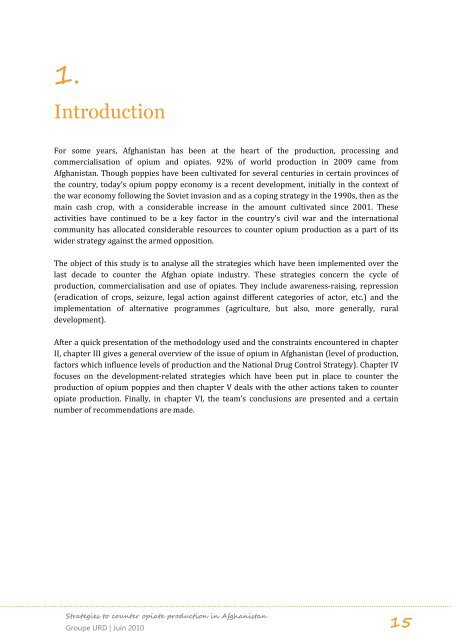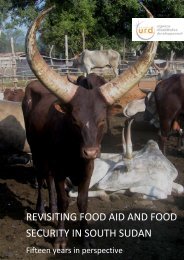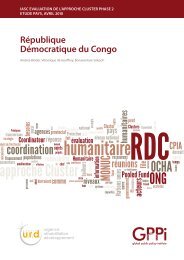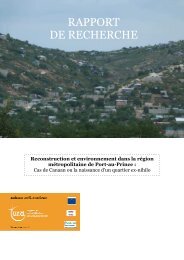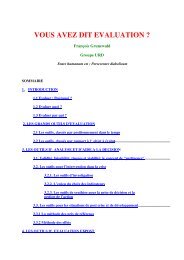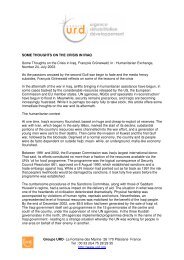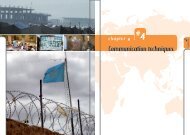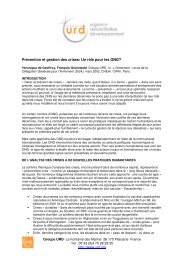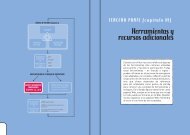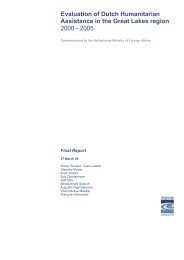strategies to counter opiate in Afghanistan - Groupe URD
strategies to counter opiate in Afghanistan - Groupe URD
strategies to counter opiate in Afghanistan - Groupe URD
You also want an ePaper? Increase the reach of your titles
YUMPU automatically turns print PDFs into web optimized ePapers that Google loves.
1.<br />
Introduction<br />
For some years, <strong>Afghanistan</strong> has been at the heart of the production, process<strong>in</strong>g and<br />
commercialisation of opium and <strong>opiate</strong>s. 92% of world production <strong>in</strong> 2009 came from<br />
<strong>Afghanistan</strong>. Though poppies have been cultivated for several centuries <strong>in</strong> certa<strong>in</strong> prov<strong>in</strong>ces of<br />
the country, <strong>to</strong>day’s opium poppy economy is a recent development, <strong>in</strong>itially <strong>in</strong> the context of<br />
the war economy follow<strong>in</strong>g the Soviet <strong>in</strong>vasion and as a cop<strong>in</strong>g strategy <strong>in</strong> the 1990s, then as the<br />
ma<strong>in</strong> cash crop, with a considerable <strong>in</strong>crease <strong>in</strong> the amount cultivated s<strong>in</strong>ce 2001. These<br />
activities have cont<strong>in</strong>ued <strong>to</strong> be a key fac<strong>to</strong>r <strong>in</strong> the country’s civil war and the <strong>in</strong>ternational<br />
community has allocated considerable resources <strong>to</strong> <strong>counter</strong> opium production as a part of its<br />
wider strategy aga<strong>in</strong>st the armed opposition.<br />
The object of this study is <strong>to</strong> analyse all the <strong>strategies</strong> which have been implemented over the<br />
last decade <strong>to</strong> <strong>counter</strong> the Afghan <strong>opiate</strong> <strong>in</strong>dustry. These <strong>strategies</strong> concern the cycle of<br />
production, commercialisation and use of <strong>opiate</strong>s. They <strong>in</strong>clude awareness-rais<strong>in</strong>g, repression<br />
(eradication of crops, seizure, legal action aga<strong>in</strong>st different categories of ac<strong>to</strong>r, etc.) and the<br />
implementation of alternative programmes (agriculture, but also, more generally, rural<br />
development).<br />
After a quick presentation of the methodology used and the constra<strong>in</strong>ts en<strong>counter</strong>ed <strong>in</strong> chapter<br />
II, chapter III gives a general overview of the issue of opium <strong>in</strong> <strong>Afghanistan</strong> (level of production,<br />
fac<strong>to</strong>rs which <strong>in</strong>fluence levels of production and the National Drug Control Strategy). Chapter IV<br />
focuses on the development-related <strong>strategies</strong> which have been put <strong>in</strong> place <strong>to</strong> <strong>counter</strong> the<br />
production of opium poppies and then chapter V deals with the other actions taken <strong>to</strong> <strong>counter</strong><br />
<strong>opiate</strong> production. F<strong>in</strong>ally, <strong>in</strong> chapter VI, the team’s conclusions are presented and a certa<strong>in</strong><br />
number of recommendations are made.<br />
Strategies <strong>to</strong> <strong>counter</strong> <strong>opiate</strong> production <strong>in</strong> <strong>Afghanistan</strong><br />
<strong>Groupe</strong> <strong>URD</strong> | Ju<strong>in</strong> 2010<br />
15


